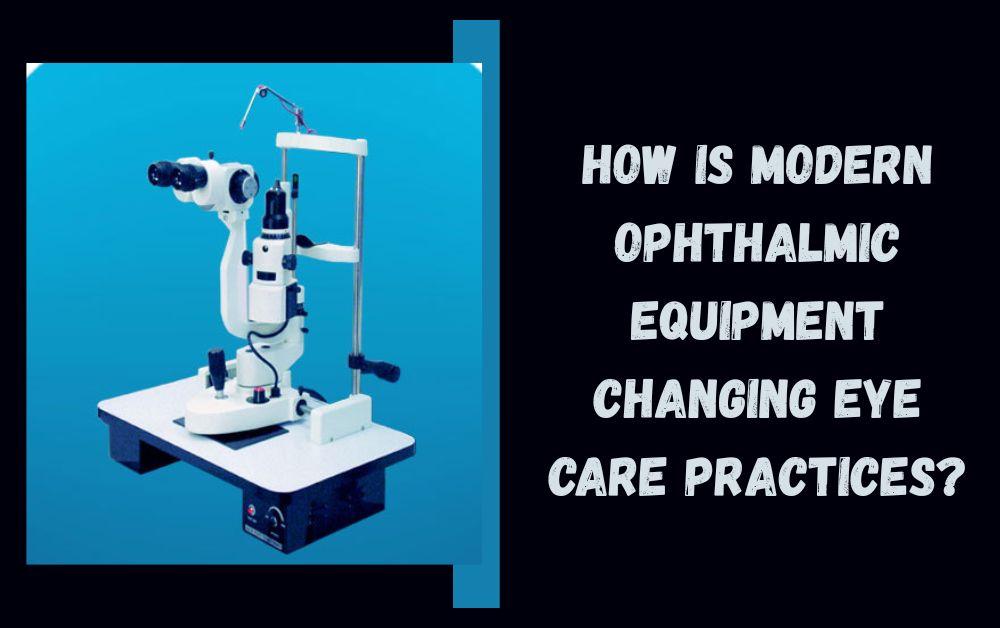Eye care has come a long way in recent years. From simple manual tools to advanced digital machines, the field of ophthalmology has seen major improvements. Today, modern ophthalmic equipment is helping doctors diagnose, treat, and monitor eye problems faster and more accurately than ever before.
In this blog, we’ll look at how modern ophthalmic equipment is transforming the way eye care professionals work, how it benefits patients, and what technologies are making the biggest difference in eye health today.
Understanding Ophthalmic Equipment
Before we look at the changes modern technology has brought, let’s first understand what ophthalmic equipment is.
What Is Ophthalmic Equipment?
Ophthalmic equipment refers to the machines, instruments, and devices used by eye doctors (ophthalmologists and optometrists) to examine and treat the eyes. These include both diagnostic and surgical tools that help in identifying conditions like:
- Cataracts
- Glaucoma
- Retinal disorders
- Refractive errors (like nearsightedness and farsightedness)
- Corneal diseases
Examples of Ophthalmic Equipment
Some commonly used ophthalmic equipment includes:
- Slit lamp – Used to examine the front part of the eye.
- Autorefractor – Measures how light changes as it enters the eye to detect vision errors.
- Tonometer – Checks eye pressure to detect glaucoma.
- Optical Coherence Tomography (OCT) – Creates detailed images of the retina.
- Phoropter – Helps determine the right prescription for glasses or contact lenses.
Each of these tools plays a key role in providing accurate and comfortable eye examinations for patients.
The Shift Toward Modern Eye Care Technology
Eye care was once fully dependent on manual examination methods. Doctors had to rely mostly on visual observation and simple lenses. But with technology advancing every year, ophthalmic equipment has become more digital, automated, and data-driven.
From Manual to Digital
Modern ophthalmic equipment now uses advanced imaging, computer analysis, and artificial intelligence (AI) to detect eye problems even before symptoms appear. This shift from manual to digital systems has improved both the accuracy and speed of eye examinations.
Improving Diagnosis and Treatment
For example, earlier, diagnosing diseases like glaucoma or diabetic retinopathy took multiple visits and manual tests. Today, digital imaging machines can detect early signs of these diseases in minutes, helping doctors start treatment sooner.
How Modern Ophthalmic Equipment Is Changing Eye Care
Modern ophthalmic equipment has revolutionized eye care in many ways. Let’s explore how these technological advancements are improving diagnosis, treatment, and overall patient experience.
1. More Accurate Diagnoses
Accuracy is the foundation of effective eye care. Small errors in diagnosis can lead to incorrect prescriptions or delayed treatment.
How Technology Improves Accuracy
Advanced imaging devices like OCT scanners and digital fundus cameras allow doctors to view the smallest structures in the eye with high detail.
They can detect diseases such as macular degeneration, glaucoma, or diabetic eye disease at very early stages — even before symptoms appear.
Benefits for Patients
- Early detection means better treatment outcomes.
- Reduces the risk of vision loss.
- Helps in monitoring long-term changes in eye health.
This precision has made eye care safer, faster, and more reliable than before.
2. Faster and More Comfortable Eye Examinations
Nobody likes long, uncomfortable eye tests. Modern ophthalmic machines have changed this by making tests quicker and easier.
User-Friendly Technology
Automated machines such as autorefactors and non-contact tonometers reduce the need for manual adjustments. Patients simply look into the machine, and the results appear on the screen in seconds.
Saving Time for Both Patients and Doctors
Because of automation, an entire eye examination that used to take 30–40 minutes can now be completed in less than 15 minutes — without compromising accuracy.
Improving Patient Comfort
Some equipment now uses gentle, non-invasive methods that reduce discomfort. For example, modern tonometers use a small puff of air instead of direct contact to measure eye pressure, which is less stressful for patients.
3. Advanced Imaging and Visualization
Eye doctors today rely heavily on imaging technology to see what’s happening inside the eye.
Digital Retinal Imaging
With high-resolution digital cameras, doctors can take detailed images of the retina — the light-sensitive layer at the back of the eye. These images help detect changes caused by conditions like diabetes or hypertension.
Optical Coherence Tomography (OCT)
OCT is one of the most advanced imaging tools in modern ophthalmology. It produces cross-sectional images of the retina, similar to how a CT scan works for other parts of the body.
It helps detect swelling, fluid buildup, or early signs of retinal damage that are not visible through standard examinations.
Benefits of Better Imaging
- Provides clear visuals for accurate diagnosis.
- Enables long-term tracking of eye conditions.
- Helps patients understand their eye health through visual explanations.
4. Early Detection of Serious Eye Diseases
Modern ophthalmic equipment allows early detection of diseases that could lead to blindness if left untreated.
Detecting Glaucoma and Retinal Diseases Early
Glaucoma, for instance, often develops silently without symptoms. Advanced tools like visual field analyzers and OCT scanners can identify early damage to the optic nerve before the patient notices vision loss.
Preventing Vision Loss
Early detection means doctors can start treatment sooner, preventing further damage and helping patients maintain their vision for longer.
5. Enhanced Surgical Precision
Modern ophthalmic technology has not only changed diagnosis but also improved surgical procedures.
Laser-Assisted Eye Surgeries
Procedures like LASIK (for vision correction) and cataract surgery now use laser systems guided by computer imaging. This makes surgeries more accurate and reduces recovery time.
Better Tools for Microsurgery
Advanced microscopes and phacoemulsification machines allow surgeons to perform delicate eye surgeries with minimal risk and faster healing.
Improved Safety for Patients
- Reduced human error during surgery.
- Smaller incisions mean less discomfort and faster recovery.
- More consistent results across procedures.
6. Integration of Artificial Intelligence (AI)
Artificial intelligence is now making its way into eye care as well.
AI in Eye Disease Detection
AI-powered ophthalmic devices can analyze thousands of eye images in seconds and detect patterns that even experienced doctors might miss.
For example, AI tools are being used to detect diabetic retinopathy, age-related macular degeneration, and glaucoma.
Supporting Doctors, Not Replacing Them
AI doesn’t replace eye doctors — it supports them by saving time, reducing manual effort, and improving accuracy.
7. Remote Eye Care and Tele-Ophthalmology
Technology has also made eye care more accessible to people living in remote areas.
How Tele-Ophthalmology Works
Through connected digital devices, doctors can now examine eye images or test results from a distance. This allows patients in rural areas to receive expert opinions without traveling long distances.
Benefits for Remote Patients
- Saves time and travel costs.
- Early diagnosis without visiting big hospitals.
- Expands access to quality eye care for all.
8. Environmentally Friendly and Energy-Efficient Equipment
Modern ophthalmic equipment is also becoming more sustainable. Manufacturers are designing machines that consume less power and use eco-friendly materials.
Why This Matters
Hospitals and clinics can reduce their environmental impact while providing the same level of high-quality care. It’s a small but important step toward greener healthcare.
How Modern Equipment Benefits Eye Care Professionals
Modern ophthalmic technology doesn’t only help patients — it also makes the work easier for doctors and technicians.
Reduced Human Error
Automation and digital analysis reduce the chance of mistakes in measurements or results.
Simplified Workflows
Connected systems allow data to be shared between departments instantly, helping doctors access patient records and images quickly.
More Time for Patient Care
Since machines handle many repetitive tasks, doctors can spend more time talking to patients, explaining results, and offering personalized care.
Challenges of Modern Ophthalmic Equipment
While these advancements are impressive, there are still some challenges to consider.
High Costs
Advanced ophthalmic equipment can be expensive, which makes it difficult for smaller clinics to afford the latest technology.
Training Requirements
Doctors and technicians must be trained properly to use the machines correctly and interpret results accurately.
Maintenance and Upgrades
Regular maintenance and software updates are needed to keep the equipment working efficiently, which adds to operational costs.
Despite these challenges, the benefits far outweigh the drawbacks, as modern technology continues to make eye care safer and more effective.
The Future of Ophthalmic Equipment
The future of ophthalmology looks bright, with technology continuing to move forward at a fast pace.
AI and Smart Diagnostics
AI will become even more advanced, allowing machines to predict potential vision problems before they occur.
Portable and Wearable Devices
We may soon see handheld or wearable eye diagnostic devices that make screening easier in any location — even outside hospitals.
3D Imaging and Virtual Reality
These technologies could allow doctors to explore eye structures in 3D, making diagnosis and surgery even more precise.
Conclusion
Modern Paramount Medical Equipment Trading LLC has completely transformed the world of eye care. From faster and more comfortable exams to highly accurate imaging and early disease detection, technology has made eye care safer, smarter, and more accessible than ever.
For patients, it means better results and fewer worries. For doctors, it means more confidence in every diagnosis and treatment.



